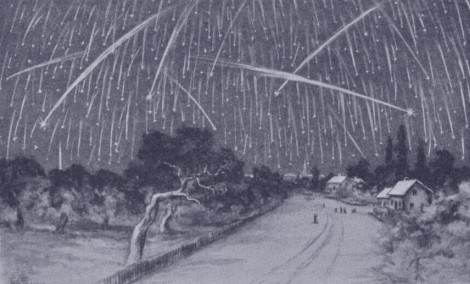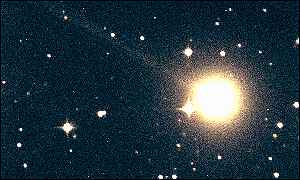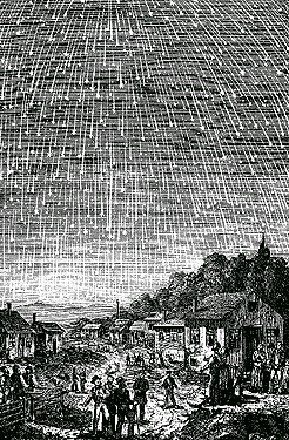LECTURE AND SLIDE SHOW
REFERENCES

Description: Over a three-night span from November 10th through November 12th, 1833, people looking skyward witnessed what is still considered to be the greatest astronomical spectacle in recorded history. It was November 11th and 12th of that year when countless meteors shot across the night sky, catching many people’s attention and interest. People knelt down and prayed or flocked to churches, thinking that the Day of Judgement was at hand. Historical astronomer John Horrigan will take you back to that day with an interactive indoor/outdoor presentation and also discuss some of the greatest meteor showers in history, including the Great Leonid Showers that were seen on November 27th, 1966 and the most recent star spectacular on November 17th, 2001. During the program, Horrigan, a Watertown resident, will prepare audience members to view the annual Perseid shower in August, in addition to helping them identify some major constellations, double stars and Messier objects. He'll help you locate the North Star, gaze at some major satellites (including the Hubble Space Telescope and International Space Station), identify craters on the moon (including landing zones of Apollo missions) and talk about the SETI project. He’ll also let attendees hear a recording of what a fireball sounds like. A comparison of both Comet Swift-Tuttle (parent of the Perseids) and Comet Tempel-Tuttle (parent of the Leonids) will also be made. A telescope and binoculars will be provided for this all-ages show. The best booking time period is in the late Spring or Summer (for an indoor/outdoor interactive lecture and post-lecture skywatch), particularly August for the Perseid meteor shower and November for the Leonid meteor shower. “The goal is to educate families and kids so they can go outside and look to the heavens on their own,” Horrigan said. “Folks need to know that there’s more to life than American Idol, the Red Sox and Wii. Ancient TV was simply looking up. We all need to be humbled every so often by our universal meekness.”













THIS LECTURE HAS BEEN PERFORMED FOR:

Running Time: 34 minutes Size: 32 MB


Running Time: 5 minutes (this is an abbreviated version!)


Running Time: 40 minutes Size: 32 MB

ADDITIONAL AUDIO RECORDINGS:
THE GREAT SEPTEMBER COMET (1882)

Recorded on December 21, 2008 at Watertown, Massachusetts. John reads from the New York Times of December 17th, 1882 about the odd behavior of a bright comet over the skies of Hartford, Connecticut on December 3th, 1882. 1 minute and 3 seconds; 1 MB
THE AURORA BOREALIS OF 1818

Recorded on December 14, 2008 at Watertown, Massachusetts. John reads about sailors who witness a bright and vivid aurora borealis in November of 1818 where a compass could be read on deck due to the luminosity. 1:33; 2 MB
THE GREAT AURORA BOREALIS OF AUGUST, 1817

Recorded on December 14, 2008 at Watertown, Massachusetts. John reads about a spectacular aurora borealis that was closely observed from the Shetland Islands in August of 1817. 3:42 3 MB
THE AURORA BOREALIS OF SEPTEMBER, 1817

Recorded on December 14, 2008 at Watertown, Massachusetts. John reads about a vivd aurora borealis that was observed and heard from the Shetland Islands on September 6th, 1817. 2:03; 2 MB
THE METEORITE OF 1807

Recorded on December 28th, 2008 in Cambridge, Massachusetts. John reads about a bolide that streaked across Western New England skies just before dawn on December 14th, 1807. Time: 3:54 Size: 4 MB
THE METEOR OF 1787

Recorded on December 5th, 2008 in Cambridge, Massachusetts. John reads from Sidney Perley's Historic Storms of New England about a bright bolide that streaked across New England skies on August 30th, 1787. Time: 5:48 Size: 5 MB
THE AURORA BOREALIS OF 1740

Recorded on December 14, 2008 at Watertown, Massachusetts. John reads about an aurora borealis that was observed by Celsius and an associate in 1740 where electromagnetic interference was detected on a compass. 3:25; 3 MB
THE AURORA BOREALIS OF 1726

Recorded on January 2nd, 2008 in Watertown, Massachusetts. John reads about an Aurora Borealis of 1726 and 1716 (that was seen by Edmund Halley).
THE GREAT AURORA BOREALIS OF 1719

Recorded on January 3rd, 2007 in Watertown, Massachusetts. John reads from Sidney Perley's Historic Storms of New England about a rare and spectacular display of the Northern Lights as glimpsed by residents all over New England in 1719.3:00, 3 MB

RETURN TO JOHN HORRIGAN HISTORICAL LECTURES
JOHN'S AUDIO CATALOGUE